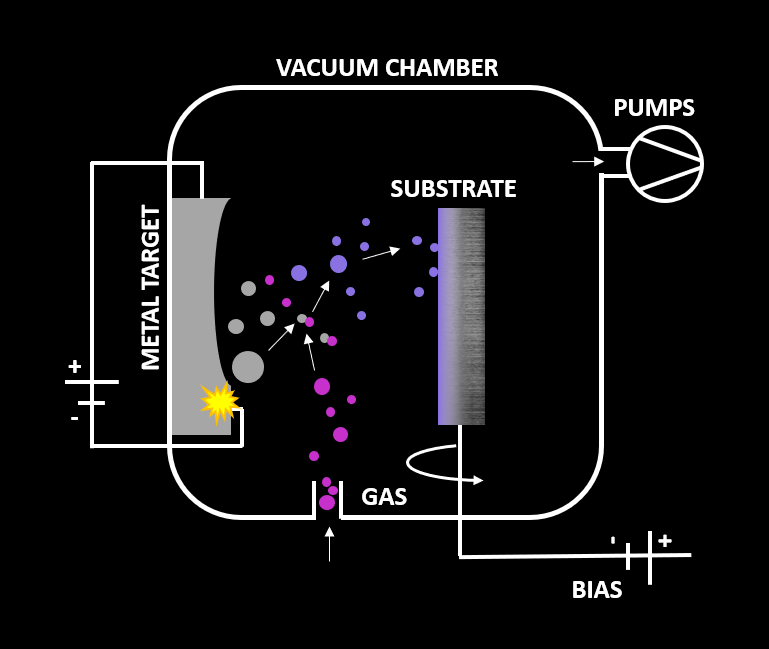PVD TECHNOLOGY
PVD TECHNOLOGY
PVD is a process with a very low environmental impact for depositing thin material films on a wide variety of products. The process is ideal for treating valuable, high-end items to make them unique and durable over time, while also enhancing their technical properties. If you are new to the PVD process and would like to learn more …
DO YOU KNOW THE PHYSICS THAT UNDERPINS OUR PROCESS?
PVD (Physical Vapor Deposition) is a process that creates high-tech and decorative coatings that enhance the properties of the treated items. The system operates under high vacuum conditions inside specially designed chambers. The materials used to create the fine films under PVD are typically "target" metals and reactive gasses, which are put into the chamber together with the item being processed. The metal target is electrically bombarded to sublimate the outer atomic layers, which react with the gas in the chamber to form reactive ions. A voltage difference is applied to the items to be coated, causing the ions to be attracted to them and forming a fine film (from 0.5 to 3 microns).

WHAT BASE MATERIALS CAN BE TREATED BY PVD?
Substrates like glass, ceramics, and metals (for example steel, chrome-plated brass, or chrome-plated Zamak) are ideal for PVD coating, giving excellent results both aesthetically and in terms of durability. Many other materials including aluminium, PEEK, brass, etc. are also suitable for PVD treatment. Contact us for information about the compatibility of your materials.
WHAT ARE THE MOST COMMONLY APPLIED PVD COATINGS?
Pure metals like titanium, zirconium, chrome, or alloys like titanium aluminium can be used to create films of TiN (titanium nitride), ZrN (zirconium nitride), CrN (chromium nitride), TiCN (titanium carbonitride), TiAlCN (titanium-aluminium carbonitride), TiO2 (titanium dioxide), and many more, based on the customer’s needs.
WHAT ARE THE TECHNICAL CHARACTERISTICS OF PVD COATINGS?
| TiN | TiCN | CrN | ZrN | |
|---|---|---|---|---|
| Hardness | 2000 - 2500 HV | 3000 - 3500 HV | 2000 - 2500 HV | 2800 - 3000 HV |
| Frictional coefficient | 0,3 - 0,4 | 0,4 - 0,5 | 0,4 - 0,5 | 0,4 - 0,5 |
| Non-toxicity and biocompatibility | Yes | Yes | Yes | Yes |
| Chemical resistance | Good | Good | Excellent | Good | MOCA compliance | Yes | Yes | Yes | Yes |
WHY CHOOSE A PVD COATING?
A PVD treatment differs from all other material surfacing methods for its:
 |
Durability. It creates an everlasting surface finish resistant to most chemical and physical agents. | |
 |
Vast range of possible colours. It is a very versatile treatment that can produce many different shades of colour, without altering the specific features of the underlying surface. | |
 |
Non-toxicity and absence of allergenic metals. For example, it is nickel free, making it suitable for coating nearly all surfaces. | |
 |
Suitability for surfacing a wide range of materials. Glass, ceramic, and metal substrates can be treated, plus many more. | |
 |
Capacity to improve items’ technical properties, simply by adding a film of just a few microns. | |
 |
Low environmental impact. The PVD system's very low energy and water consumption and the absence of chemicals in the process makes it environmentally friendly. |